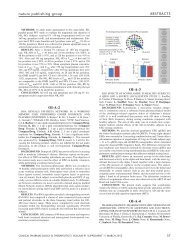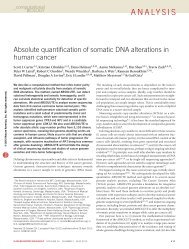open access: Nature Reviews: Key Advances in Medicine
open access: Nature Reviews: Key Advances in Medicine
open access: Nature Reviews: Key Advances in Medicine
You also want an ePaper? Increase the reach of your titles
YUMPU automatically turns print PDFs into web optimized ePapers that Google loves.
P = 0.03). When the analysis was limited to<br />
patients with histologically confirmed renal<br />
cell carc<strong>in</strong>oma, these differences <strong>in</strong> overall<br />
survival were less pronounced.<br />
The f<strong>in</strong>d<strong>in</strong>gs of this study must be placed<br />
<strong>in</strong> context of its limitations. Designed to<br />
recruit 1,300 patients, the trial was closed<br />
early due to poor accrual, and did not<br />
achieve the target sample size chosen to<br />
identify a 3% difference <strong>in</strong> 5-year survival.<br />
In addition, there were differences<br />
<strong>in</strong> basel<strong>in</strong>e comorbidities and considerable<br />
crossover between treatment arms (5.6%<br />
of patients randomized to radical nephrectomy<br />
underwent partial neph rectomy,<br />
and 14.6% of patients randomized to partial<br />
nephrectomy underwent radical nephrectomy),<br />
which may have <strong>in</strong>fluenced the<br />
reported survival outcomes. Despite these<br />
limitations, the f<strong>in</strong>d<strong>in</strong>gs raise important<br />
questions regard<strong>in</strong>g the relative contributions<br />
of preserved renal function and compet<strong>in</strong>g<br />
risks from pre-exist<strong>in</strong>g comorbidities<br />
to overall survival follow<strong>in</strong>g surgical resection<br />
for localized renal tumors. Although<br />
these results are thought-provok<strong>in</strong>g, further<br />
study is necessary to determ<strong>in</strong>e which<br />
patients stand to benefit the most from<br />
nephron-spar<strong>in</strong>g surgery.<br />
The benefit of renal function preservation<br />
<strong>in</strong> nephron-spar<strong>in</strong>g surgery must<br />
be weighed aga<strong>in</strong>st the <strong>in</strong>creased risk of<br />
postoperative complications compared<br />
with radical nephrectomy. 2 However, a<br />
lack of standardized report<strong>in</strong>g methods<br />
has resulted <strong>in</strong> a body of literature with<br />
limited generalizability that is challeng<strong>in</strong>g<br />
to <strong>in</strong>terpret. In 2011, <strong>in</strong>vestigators at<br />
Fox Chase Cancer Center attempted to<br />
address these issues by rigorously evaluat<strong>in</strong>g<br />
the complica tions associated with<br />
partial neph rectomy <strong>in</strong> their <strong>in</strong>stitutional<br />
database 4 us<strong>in</strong>g the Clavien-D<strong>in</strong>do<br />
classifica tion system (CCS). 5 Aim<strong>in</strong>g to<br />
provide a benchmark for comparative<br />
studies between <strong>in</strong>stitutions, patients were<br />
stratified us<strong>in</strong>g the nephrometry scor<strong>in</strong>g<br />
system 6 to <strong>in</strong>vestigate the relationship<br />
between tumor complexity (low complexity<br />
score 4–6; <strong>in</strong>termediate complexity score<br />
7–9; high complexity score 10–12) and risk<br />
of postoperative complications. The study<br />
cohort consisted of 390 patients with available<br />
imag<strong>in</strong>g data for review, who underwent<br />
partial neph rectomy between 2007<br />
and 2010; 109 (28%), 217 (55.6%), and<br />
64 (16.4%) patients underwent nephron-<br />
spar<strong>in</strong>g surgery for low, <strong>in</strong>termediate, and<br />
high complexity lesions, respectively. The<br />
overall proportion of patients <strong>in</strong>curr<strong>in</strong>g<br />
m<strong>in</strong>or (CCS I–II) and major (CCS III–V)<br />
complications were 26.7% and 11.5%,<br />
respectively. No significant differences were<br />
observed <strong>in</strong> m<strong>in</strong>or complications between<br />
complexity groups, but patients with highly<br />
complex lesions were more likely to develop<br />
a major complication requir<strong>in</strong>g secondary<br />
<strong>in</strong>tervention than <strong>in</strong>termediate and low<br />
complexity tumors (22% versus 11% versus<br />
6%; P = 0.001). Controll<strong>in</strong>g for demographic<br />
and cl<strong>in</strong>ical characteristics, patients with<br />
highly complex renal tumors were 5.4 times<br />
(95% CI 1.2–24.2) more likely to susta<strong>in</strong> a<br />
major complication compared to those with<br />
low complexity lesions. Although this study<br />
was limited by its retrospective methodology<br />
and lack of external validation, these<br />
f<strong>in</strong>d<strong>in</strong>gs highlight two important po<strong>in</strong>ts: the<br />
rigorous report<strong>in</strong>g of complications us<strong>in</strong>g<br />
standardized report<strong>in</strong>g methodology is<br />
essential for compar<strong>in</strong>g outcomes between<br />
<strong>in</strong>stitutions, and the benefit of nephron<br />
preserva tion <strong>in</strong> highly complex tumors<br />
comes with the attendant risk (>20%) of a<br />
major post operative complication.<br />
Recent evidence suggests that a substantial<br />
proportion of the rapidly ris<strong>in</strong>g<br />
number of <strong>in</strong>cidentally diagnosed small<br />
renal masses represents <strong>in</strong>dolent disease<br />
<strong>Key</strong> advances<br />
■ In a recent phase III randomized trial, 3<br />
partial nephrectomy demonstrated<br />
equivalent cancer-specific survival to<br />
radical surgery for tumors ≤5 cm, but did<br />
not demonstrate the expected overall<br />
survival benefit<br />
■ The benefit of nephron preservation<br />
<strong>in</strong> highly complex tumors comes with<br />
the attendant risk (>20%) of a major<br />
postoperative complication 4<br />
■ A large proportion of small renal masses<br />
under observation grow slowly, and<br />
the short-term risks of progression or<br />
metastasis under active surveillance are<br />
low 9<br />
UROLOGY<br />
that may not require treatment. 7 As a<br />
result, much attention has been directed<br />
towards describ<strong>in</strong>g the natural history of<br />
untreated renal tumors <strong>in</strong> an effort to identify<br />
which lesions are safe to observe and<br />
which require early def<strong>in</strong>itive <strong>in</strong>tervention. 8<br />
In 2011, Jewett et al. 9 reported the results<br />
of a multicenter prospective phase II trial<br />
<strong>in</strong>vestigat<strong>in</strong>g the growth k<strong>in</strong>etics and progression<br />
rates of 209 <strong>in</strong>cidentally diagnosed<br />
cT1a lesions under observation <strong>in</strong><br />
patients deemed unfit for surgery ow<strong>in</strong>g<br />
to advanced age, comorbidity, or refusal<br />
of other treatment. 9 In this cohort of 178<br />
patients (mean age 73 years, mean tumor<br />
size 2.3 cm), the authors def<strong>in</strong>ed tumor progression<br />
as growth to ≥4 cm, tumor volume<br />
doubl<strong>in</strong>g time ≤12 months, or progression<br />
to metastatic disease. Notably, 99 patients<br />
(56%) underwent renal biopsy and 127<br />
patients (151 masses) were followed up for<br />
>12 months (mean 28 months). Important<br />
study f<strong>in</strong>d<strong>in</strong>gs <strong>in</strong>clude an average growth<br />
rate of 0.13 cm per year, documented progression<br />
(as def<strong>in</strong>ed above) <strong>in</strong> 27 patients<br />
(15%), and only two patients (1.1%) develop<strong>in</strong>g<br />
evidence of metastatic disease.<br />
Furthermore, there was no difference <strong>in</strong><br />
growth rate between biopsy-proven malignant<br />
and benign disease (0.14 cm per year<br />
versus 0.17 cm per year; P = 0.8), and 36% of<br />
biopsy-proven renal cell carc<strong>in</strong>omas showed<br />
either no evidence of growth or a decrease<br />
<strong>in</strong> size. Although limited by lack of central<br />
pathology review, elevated nondiagnostic<br />
biopsy rate (33%), and short duration of<br />
follow-up, this study should be commended<br />
for its rigorous eligibility criteria, use of protocol<br />
renal mass biopsy, and strict def<strong>in</strong>ition<br />
of tumor progression. These f<strong>in</strong>d<strong>in</strong>gs add<br />
significantly to the grow<strong>in</strong>g body of literature<br />
document<strong>in</strong>g that a large proportion of<br />
small renal masses under observation grow<br />
slowly, and that short-term risks of progression<br />
or metastasis under active surveillance<br />
are low. 8,10<br />
In the absence of level 1 evidence, physicians<br />
are <strong>in</strong>creas<strong>in</strong>gly challenged to manage<br />
risk on a patient by patient basis. Although<br />
the list of unanswered questions rema<strong>in</strong>s<br />
long, the studies described above each<br />
provide evidence to improve risk communication<br />
and enable tradeoff decisions<br />
when counsel<strong>in</strong>g patients diagnosed with<br />
localized renal tumors. Until the ability to<br />
match treatment to tumor biology has been<br />
achieved, urologists must cont<strong>in</strong>ue to vigilantly<br />
evaluate and challenge contemporary<br />
management strategies, objectify tradeoff<br />
risks, and <strong>in</strong>dividualize treatment strategies.<br />
KEY ADVANCES IN MEDICINE JANUARY 2012 | S85<br />
© London_england | Dreamstime.com








